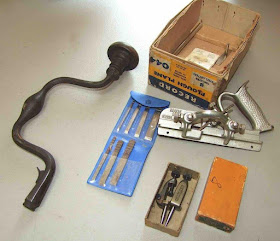A dado plane is similar to a Rabbet plane but characterized by the addition of a depth stop and a nicker ahead of the main cutter, which is normally skew since we are cutting cross grain.
First time I ran into this planemaker, so looked him up and this is what little I found about him.
We know from his indenture papers , when he was 16, he apprentices for 4 years, 5 months and 13 days under Emos Baldwin (in business 1817-29, became A & E Baldwin 1830-41)
J.W Farr was in business from 1832-51
J.W. Farr & Co, no date given but presumably post 1851
He was one of the many NY plane makers that were trained by the Baldwins.
In those days, numerous wannabee planemakers were trained by either Baldwin or Chapin, who were two of the biggest wooden planemakers of their days.
After their apprenticeship were completed, many left the immediate area and went to established themselves as planemakers.
Here is a list which contains no doubt many of these apprenticed under Baldwin or Chapin
J.W. FARR & Co
N.York (inc)
The maker stamp & Co signifies it was made post 1851.
According to my copy of the Pollack's Guide to American Wooden Planes and their makers, his plane of this imprints (D) are rated 1 star for rarity meaning: Uncommon, denotes between 250 and 500 examples known.
Mind you my copy is from 1989, I'm sure that rating has changed since...
There are 5 imprints known for JW Farr.
Number 2 (B) is 3 stars, very rare, between 50 and 100
Now lets see how this plane was made.
The depth stop is adjusted by a big brass thumb screw.
The plane at parade rest (military term for stripped down).
There is a lot of work on this small body.
To remove the depth stop shoe, simply unscrew (extend)
the shoe until it separate. two screws release this assembly.
The adjuster knob is brass but the screw thread rod is steel.
It's a good thing :-)
The depth stop shoe is a bit rough, will need some judicious filing.
A bit rusty, but nothing serious. Cleaning it will make it operate smoothly.
Very typical mechanism BTW.
The two wedges and cutters, in good shape.
Yes the irons need badly to be sharpened but nothing serious
and lots of meat left to sharpen.
I was working on my kitchen table (Oups sorry Heather :-)
So I grabbed this glass top saver to quickly assess the condition of the body.
No need for machinist straight edge, just making sure there are no bow or twist in the body.
The rear hole thru the body is a former user modification.
It does detract from its collectible value but not as a users.
Notice the skew mortise, tricky...
The recess for screwing the brass plate of the depth stop adjuster will require
some fixing in order to securely screw them in.
It does screw tight-ish, but I would not trust it, and will address that.
Overall a welcome addition to my stables of planes in my tills, will make a good user. Now I need to clean both the wood and metal parts. I am going to try a new product for the wood parts. I gave up trying to find Kramers antique improver here in Canada and it is rather pricey. Found this similar product here in Canada, Dr Woodwell's wood elixir, that I will try. Will let you know how it perform.
Bob, with a growing accumulation of recent acquisition on my kitchen table. have to use the dining room table to eat :-)
Yes, Heather I will clean up my mess... What mess, it was Rudy :-)
































































